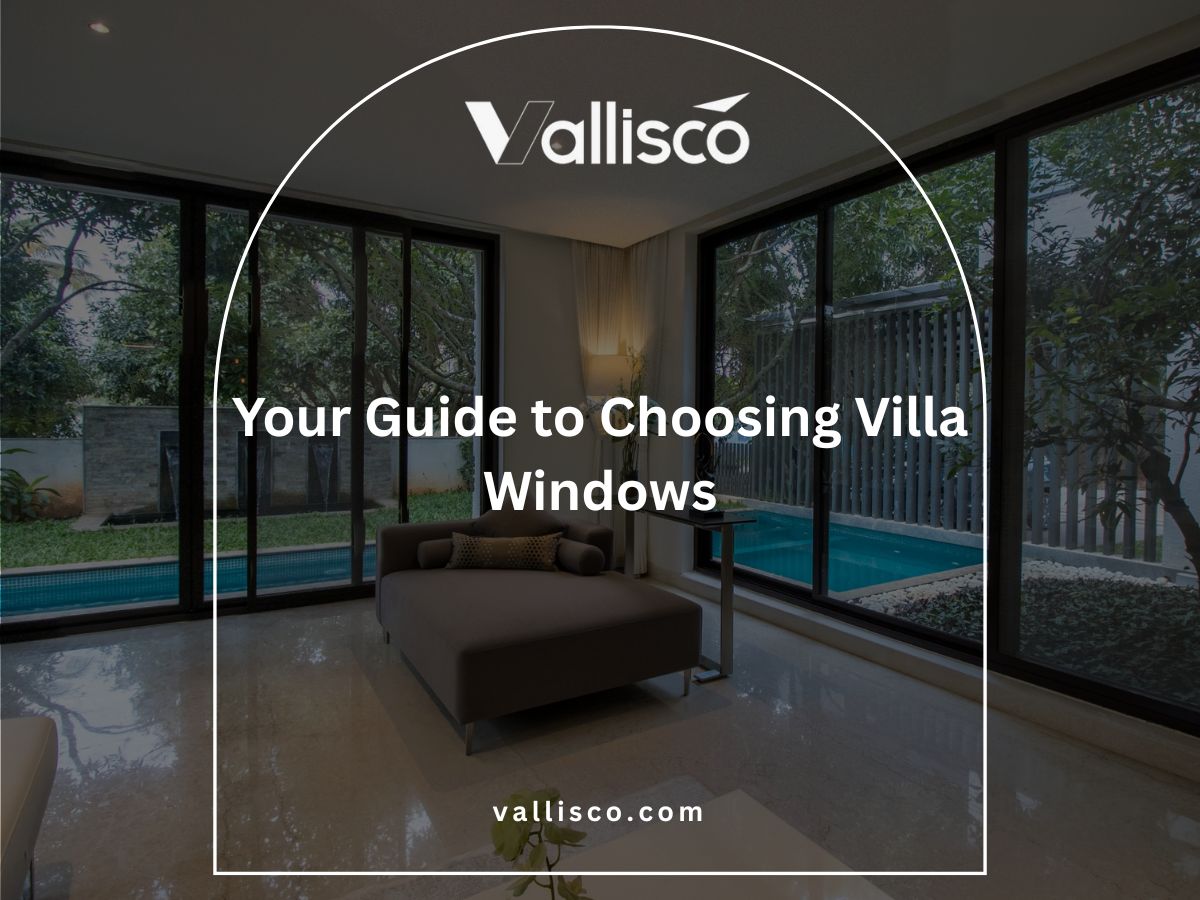On one villa project, the owners complained they could hear the kitchen noise in the guest rooms. The wrong doors made their luxury build feel cheap.
That taught me how important soundproof doors are for comfort and value.
I’ve spent years helping businesses like villas, hotels, and B&Bs choose the right doors and windows. My reviews come from handling real installations, not just reading product sheets.
This article explains the best soundproofing doors, their pros and cons, and which ones work best for your type of property. You’ll walk away with answers you can act on.
If noise is leaking through, you already know how much frustration it causes.
So, let’s dive in!
Comparison Chart
Here’s a quick side-by-side look at each door option to give you a glimpse of how they compare. We’ll dive much deeper into each one in the next sections.
| Door Type | Soundproof Level | Common Materials Used | Things to Consider | Best For |
| Solid Core Wooden Doors | Good | Hardwoods, softwoods, mixed solid cores | Heavier weight may need stronger frames | Hotels, villas, houses |
| Engineered MDF or HDF Doors | Good | MDF or HDF with wood veneers | Less resistant to moisture compared to solid wood | Offices, B&Bs, hotels |
| Specialty Acoustic Doors | Excellent | Multi-layers, insulation, seals, sometimes lead | Higher upfront cost, but unmatched performance | Studios, music rooms |
| Metal Doors with Insulated Cores | Very Good | Steel or aluminum skins + insulated cores | Can look industrial, may need aesthetic finishes | Secure areas, modern hotels |
| Laminated Acoustic Doors | Good | Wood or MDF core + laminate sheets | Laminate surface can scratch with rough handling | Stylish hotels, villas |
| Double Door Systems (Vestibule) | Excellent | Two separate doors with air gap | Need more space for installation | Busy streets, luxury hotels |
| Acoustic Sliding Doors | Fair to Good | Solid panels with seals (wood, composite) | Seals can wear over time, reducing effectiveness | Small rooms, modern builds |
| Composite Hybrid Doors | Good | Engineered wood + mixed layers | Mixed materials vary in quality and longevity | Villas, guesthouses |
| Doors with Integrated Drop Seals | Boosts any door | Rubber or silicone seals at bottom edge | Seals may require regular adjustment or replacement | Anywhere needing quiet |
Now that you’ve got this quick overview, let’s explore each door in more detail and see what makes them stand out.
1. Solid Core Wooden Doors
I’ve worked with solid core wooden doors on many villa and hotel projects, and they’re often the go-to choice for soundproofing. If you want a balance of performance and appearance, this option is worth a closer look.
Materials Used
- Hardwood Veneers: Species like oak, maple, or walnut are commonly used on the surface. They provide a polished, premium look that adds character to the property.
- Solid Wood Chips or Blocks: The core is filled with dense wood particles or engineered blocks. This weight increases durability and improves sound resistance.
- Strong Adhesives: Industrial-grade glues hold the layers tightly together. They prevent gaps or weak points that could reduce soundproofing performance.
- Edge Banding: Strips of solid wood are applied to the sides of the door. I know from experience that this keeps edges from chipping in busy properties.
- Acoustic or Fire Seals: Extra sealing materials can be added around the edges. They enhance both sound reduction and safety in commercial spaces.
Advantages
- High Durability: Solid core doors stand up well to daily use in hotels, villas, or B&Bs. They resist warping and last longer than lighter alternatives.
- Natural Density: The heavy build naturally blocks more noise than hollow options. This creates a quieter and more private environment for guests or residents.
- Aesthetic Value: The wooden surface gives a warm, classic style that appeals to luxury builds. It blends easily with most interior designs.
- Easy Availability: Solid core wooden doors are widely available from many suppliers. This makes sourcing and replacement simpler compared to specialty doors.
Things To Consider Before Buying
- Heavy Weight: These doors are much heavier than hollow ones. You’ll need stronger hinges, sturdy frames, and professional installation.
- Cost Factor: They are more expensive than hollow core doors. Still, they remain cheaper than advanced acoustic options on the market.
- Maintenance Needs: The finish requires upkeep in high-traffic areas. Refinishing or sealing is necessary to maintain their appearance over time.
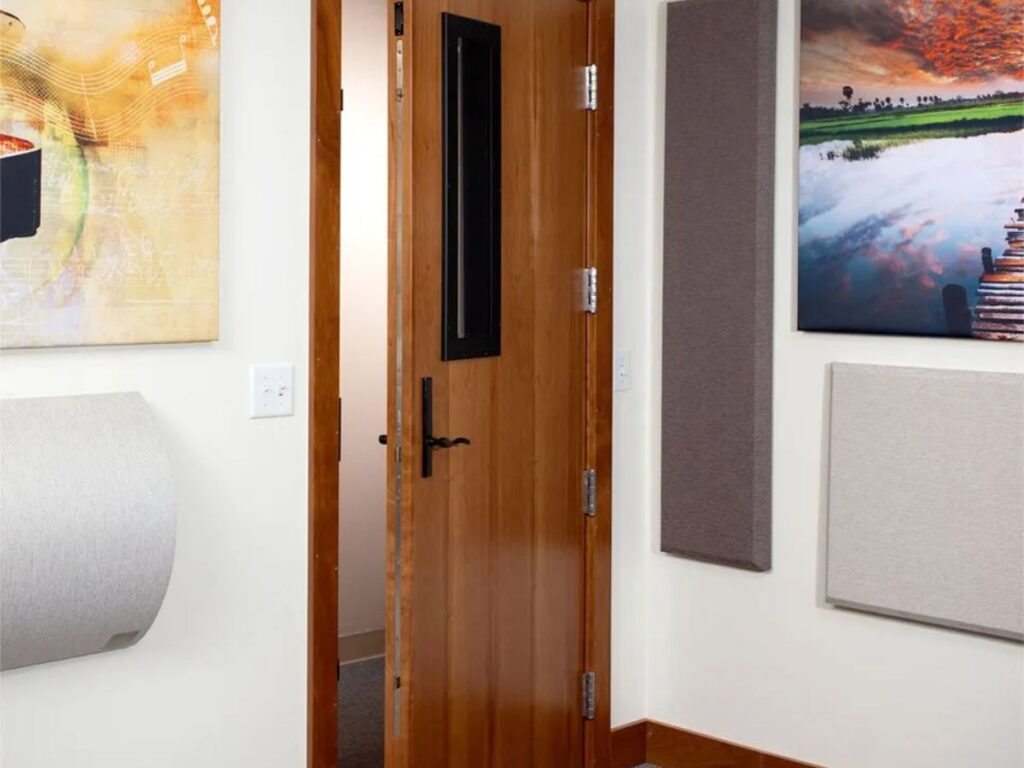
2. Engineered MDF or HDF Solid Core Doors
Engineered MDF and HDF solid core doors are built from compressed wood fibers and resins. They provide strength, consistency, and smooth finishes that work well in many commercial projects. If you need a door that balances performance, cost, and style, these are a practical option.
Materials Used
- Medium-Density Fiberboard (MDF): Made from wood fibers bonded with resin, MDF creates a smooth surface for paint or laminate finishes. I’ve recommended it to projects where a uniform appearance was non-negotiable.
- High-Density Fiberboard (HDF): Denser than MDF, HDF increases strength and sound resistance. It also holds up well in areas with frequent use.
- Resin Binders: Special adhesives bind fibers together under pressure. This results in a durable material that resists cracking or splitting.
- Veneer or Laminate Finishes: These are applied on the outer surface. They allow properties to match specific styles or branding requirements.
- Acoustic Core Additives: Some engineered cores include sound-dampening layers. These upgrades help improve soundproofing performance.
Advantages
- Cost-Effective: These doors cost less than solid wood while still delivering reliable strength. For large villa or hotel projects, this can lower overall budgets.
- Consistent Appearance: Every door looks identical, which is key for businesses that want a uniform style.
- Good Sound Resistance: The density of MDF and HDF reduces sound transfer. I’ve compared these with hollow cores before, and the difference in room comfort was clear.
- Flexible Finishing Options: Paint, laminate, or veneer can be applied. That makes it easier to align with different property aesthetics.
Things To Consider Before Buying
- Moisture Sensitivity: MDF and HDF can swell if exposed to humidity. Sealing or protective finishes are important in damp climates.
- Weight Consideration: While not as heavy as solid wood, they’re still heavier than hollow doors. Strong hinges and hardware are needed.
- Lifespan Factor: These doors may wear out sooner than solid wood in busy areas. Replacements might be needed more often in high-traffic projects.
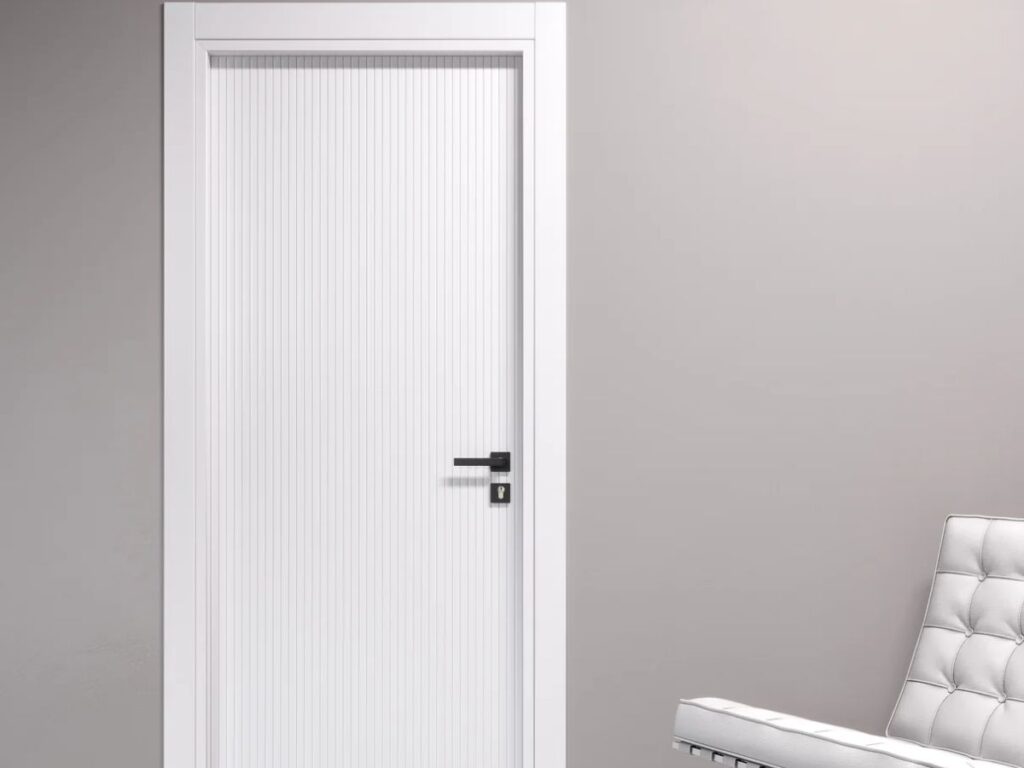
3. Specialty Acoustic Doors
Specialty acoustic doors are built specifically to block noise at a much higher level than standard options. They’re common in hotels, studios, and commercial spaces where sound privacy is critical. I’ve recommended them on projects where normal solid core doors simply weren’t enough.
Materials Used
- Acoustic-Rated Cores: These cores use dense, multi-layered materials that absorb and block sound. I’ve specified them before for hotel conference areas where noise reduction was essential.
- Steel or Composite Skins: Outer layers are made of steel, fiberglass, or reinforced composite. These materials add strength and enhance sound isolation.
- Acoustic Seals: Specialized perimeter and bottom seals close gaps around the door. This keeps sound from leaking through edges.
- Sound-Blocking Laminates: Thin laminate layers are added to improve overall sound transmission class (STC) ratings. They’re often used in performance or recording venues.
- Fire and Safety Additives: Many models include fire-rated materials. These give added protection while maintaining acoustic performance.
Advantages
- Superior Soundproofing: These doors achieve high STC ratings, making them ideal for hotels, theaters, and offices that demand privacy. Vallisco offers advanced acoustic door solutions that are tested to meet strict performance standards, giving your property reliable noise control where it matters most.
- Safety Compliance: Many meet both acoustic and fire safety standards. This saves time when you’re dealing with building codes.
- Durability in Demanding Environments: They hold up well in busy commercial spaces with constant use. I’ve noticed they keep performing even after years of service.
- Professional Appearance: Despite their heavy build, they can still be designed with finishes that match the property’s look.
Things To Consider Before Buying
- High Cost: Specialty acoustic doors are among the most expensive options. For large projects, this can quickly increase overall budgets.
- Complex Installation: They require skilled installation to perform correctly. I’ve seen performance drop drastically when contractors skipped the sealing details.
- Weight and Hardware Needs: These doors are very heavy and need reinforced frames, hinges, and sometimes automatic closers. This adds to the total cost and planning.
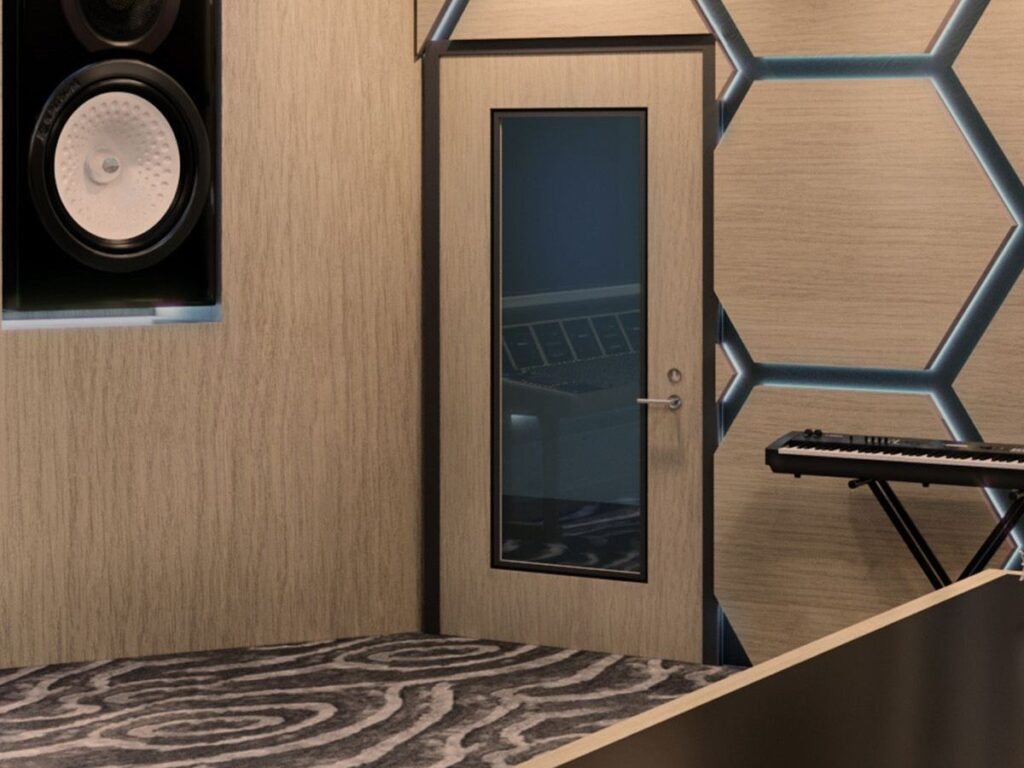
4. Metal Doors with Insulated Cores
Metal doors with insulated cores are often chosen for projects where strength and sound control both matter. They’re common in commercial buildings, hotels, and service areas where durability is just as important as noise reduction.
Materials Used
- Galvanized Steel Skins: Outer panels are usually galvanized steel sheets. They provide strong resistance to impact and daily wear.
- Insulated Foam Cores: Cores are filled with polyurethane or polystyrene foams. I’ve found these materials improve thermal and acoustic insulation together.
- Reinforced Frames: The frame is designed to support the extra weight of metal doors. This helps maintain long-term stability.
- Powder-Coated Finishes: A powder coating is often applied for protection. It also gives the door a clean, professional appearance.
- Optional Acoustic Seals: Edge and bottom seals can be added. These improve both soundproofing and energy efficiency.
Advantages
- High Durability: Metal skins resist dents, scratches, and impact. This makes them a strong fit for hotels and commercial service areas.
- Improved Sound Blocking: The insulated core helps reduce noise transfer. I’ve compared them on-site with hollow metal doors, and the difference was clear.
- Fire and Safety Ratings: Many insulated metal doors meet fire safety codes. This helps meet compliance without additional modifications.
- Low Maintenance: The powder-coated finish requires little upkeep. This saves time for facilities with large numbers of doors.
Things To Consider Before Buying
- Installation Complexity: These doors require precise fitting to achieve both soundproofing and durability. Poor installation reduces their performance.
- Hardware Compatibility: The weight of insulated cores means you’ll need heavy-duty hinges and closers.
- Temperature Expansion: Metal can expand or contract with temperature changes. This may affect alignment if not installed correctly.

5. Laminated Acoustic Doors
Laminated acoustic doors are designed with multiple layers pressed together to improve sound control. I was involved in a project where this type of door helped deliver strong acoustic results without the bulk of heavy specialty doors.
Materials Used
- Laminated Wood Layers: Several thin sheets of wood are pressed together. This layered design improves both strength and sound dampening.
- Acoustic Vinyl Interlayers: A soundproofing vinyl sheet is often placed between laminates. I noticed how well this reduced mid-to-high frequency noise during an office fit-out.
- Decorative Veneers or Laminates: Outer layers can be customized with different finishes. This helps match the door to the property’s overall style.
- Compression Adhesives: High-pressure adhesives bond the layers tightly. This prevents weak points and keeps the door solid.
- Optional Glass Inserts: Some laminated acoustic doors include double or triple-glazed panels. These allow light without sacrificing sound control.
Advantages
- Strong Acoustic Performance: The layered structure blocks more sound than standard solid wood. This makes them useful for guest rooms or meeting areas.
- Design Flexibility: The surface can be finished in many styles. I had a hotel client choose this option to match branding while improving guest comfort.
- Durability: Laminated layers resist warping better than single-piece wood. This means longer service life in busy commercial spaces.
- Balanced Weight: They are lighter than full specialty acoustic doors. That makes installation easier while still providing strong performance.
Things To Consider Before Buying
- Edge Protection: The laminated edges can chip if not reinforced. Adding proper trims or edge guards is important in high-traffic areas.
- Moisture Concerns: If not sealed well, laminated layers may separate in humid conditions. Extra finishing treatments are often needed.
- Cost Variation: Pricing depends on the thickness of laminates and the type of acoustic inserts. I once had to help a contractor reorder because the wrong grade was delivered.
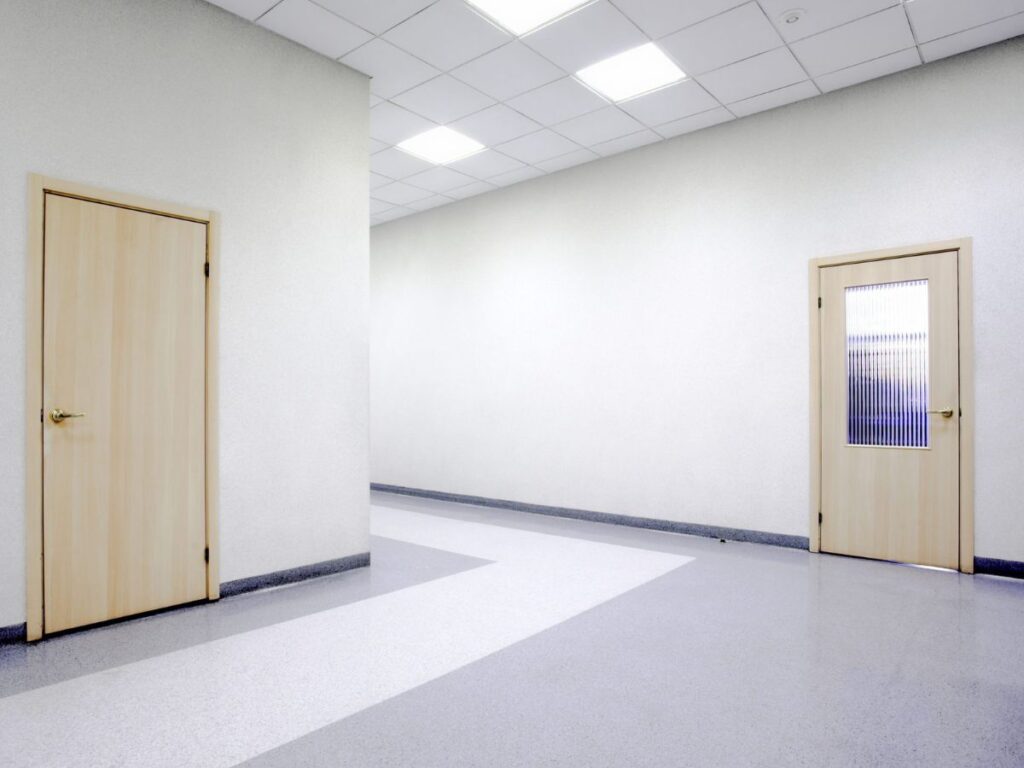
6. Double Door Systems (Vestibule Style)
Double door systems, also called vestibule setups, use two doors separated by a small air gap. This design creates a buffer zone that significantly reduces sound transfer. I recommend this type when outside noise is a constant problem for hotels, villas, or commercial properties.
Materials Used
- Outer Entry Door: Often made from metal, fiberglass, or heavy wood. I’ve worked with projects where this first barrier absorbed most of the exterior noise.
- Inner Acoustic Door: Usually solid core or laminated acoustic. It provides the second shield before noise enters guest or office spaces.
- Insulated Air Gap: The space between both doors works as a sound buffer. This “dead air” zone is key to the system’s performance.
- Sealing Systems: Acoustic gaskets and threshold seals are added to both doors. These stop sound leakage around edges and floors.
- Reinforced Frames: Frames must support two doors and their hardware. Strong framing keeps the system stable over years of use.
Advantages
- Superior Noise Reduction: Two doors with an air gap block far more noise than single-door setups. This is especially valuable in hotels and commercial entrances.
- Energy Savings: Vestibules also limit heat and cooling loss by trapping air. I noticed this setup lower HVAC demand on a property with high foot traffic.
- Added Security: Having two doors provides an extra barrier to entry. This makes them suitable for properties that require strong access control.
- Professional Appearance: A vestibule creates a formal and polished entry point. This helps upscale properties project a higher-quality image.
Things To Consider Before Buying
- Space Requirements: Vestibule systems need more floor space to fit two doors. Compact properties may not have enough room.
- Installation Complexity: Both doors must be carefully aligned. Mistakes during installation reduce their acoustic performance.
- Maintenance Demand: Two doors double the hardware and seals to maintain. I’ve had to set up regular service checks to keep them operating smoothly.
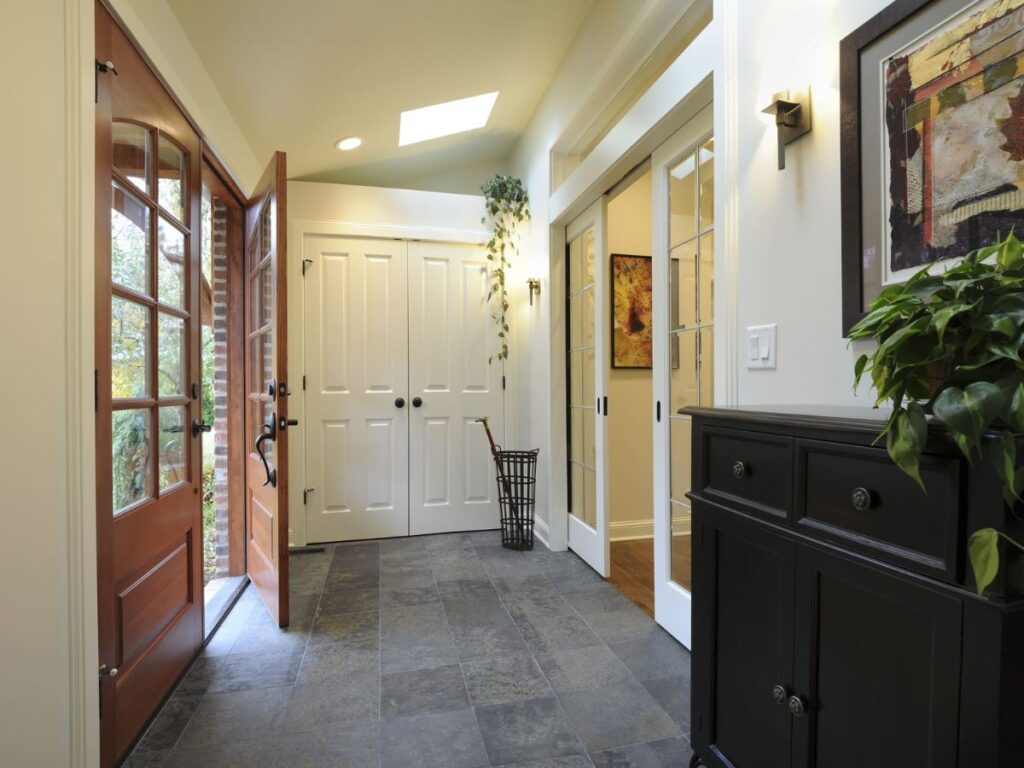
7. Acoustic Sliding Doors
Acoustic sliding doors are designed for properties where space is limited but noise reduction is still a priority. They combine sliding mechanisms with soundproofing features to give flexibility and performance. I’ve helped clients choose this option when traditional swinging doors were simply not practical for their layouts.
Materials Used
- Laminated Glass Panels: Many acoustic sliding doors use double or triple laminated glass. These layers reduce noise while still letting in natural light.
- Solid Acoustic Panels: Some models are built with solid cores and veneers. I worked on a project where this style provided both privacy and a modern look.
- Acoustic Seals: Specialized seals are fitted around the track and frame. They close gaps that sliding doors naturally create.
- Heavy-Duty Tracks: Reinforced track systems carry the weight of thicker acoustic panels. This ensures smooth operation without sagging.
- Metal or Composite Frames: Frames support the structure while keeping vibration transfer low. They also extend the lifespan of the sliding system.
Advantages
- Space-Saving Design: Sliding doors don’t swing into rooms, making them ideal for smaller spaces. This is especially useful in hotels or offices with tight layouts.
- Good Acoustic Performance: While not as strong as vestibule systems, they still provide solid sound reduction.
- Modern Appearance: The sleek design matches contemporary interiors. They help properties maintain a professional, updated look.
- Flexible Applications: Can be used for guest rooms, offices, or shared work areas. This makes them versatile for both residential and commercial projects.
Things To Consider Before Buying
- Seal Maintenance: The acoustic seals need regular checks. If they wear out, soundproofing effectiveness drops quickly.
- Track Durability: Sliding systems depend on smooth track function.
- Lower STC Ratings: Sliding doors usually don’t achieve the same sound ratings as double or specialty doors. They’re best where space savings are as important as noise control.
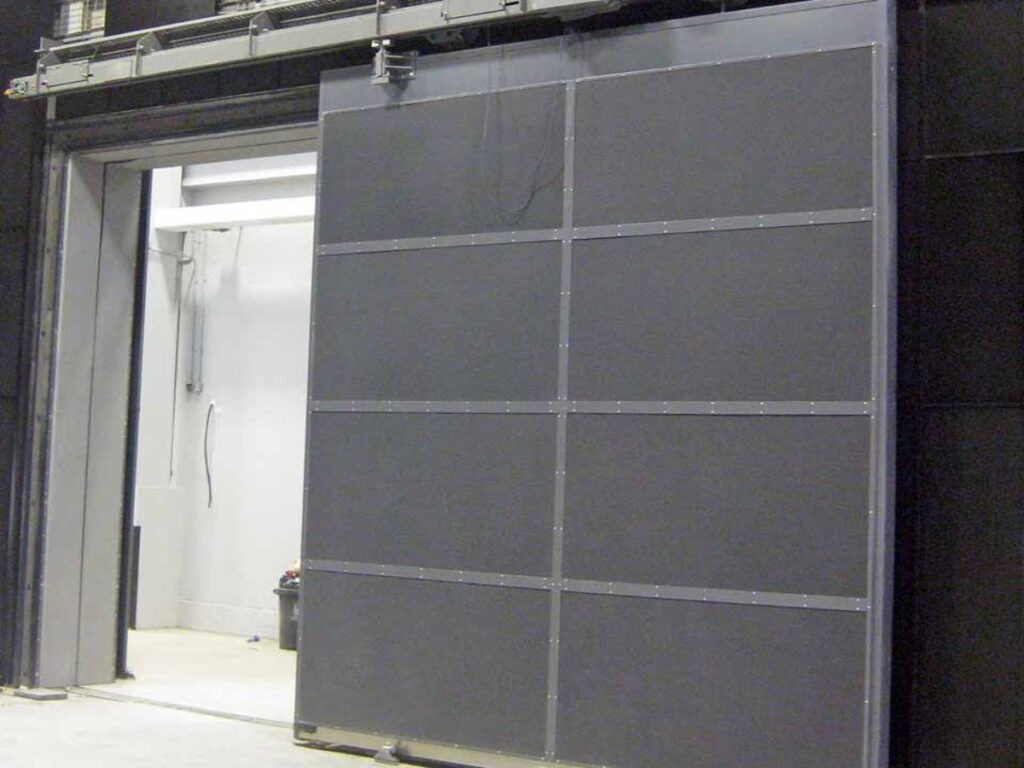
8. Composite Hybrid Doors
Composite hybrid doors combine several materials into one design to improve both soundproofing and durability. I like these options for projects where your property needs strength, noise control, and design flexibility in one door.
Materials Used
- Layered Wood and MDF Panels: Outer layers are often finished with wood or MDF. This gives a professional look while still contributing to sound control.
- Metal Reinforcements: Steel or aluminum inserts are used to add strength. I came across this setup in a build where durability had to match acoustic needs.
- Acoustic Core Fillers: Dense composites, foams, or fiber materials are placed in the core. These fillers improve sound resistance and thermal insulation.
- Laminated Surfaces: Decorative laminates or veneers are pressed onto the surface. This helps meet style requirements for hotels and offices.
- Bonding Resins: Strong adhesives keep multiple layers firmly connected. This prevents separation over time in high-use environments.
Advantages
- Balanced Performance: Composite hybrids combine the best features of wood, metal, and engineered materials. This makes them versatile across different building types.
- Durability with Style: They resist dents and warping while still offering design flexibility. I tested one during a villa renovation and saw it outperform a plain wood door.
- Improved Acoustic Control: The layered core reduces noise transfer effectively. This is especially useful for offices, villas, and hospitality spaces.
- Customizable Finishes: A wide range of finishes and designs are available. This allows businesses to match brand identity while maintaining function.
Things To Consider Before Buying
- Complex Manufacturing: With multiple materials in one door, production times can be longer. This can affect delivery schedules on large projects.
- Installation Needs: Mixed materials may require skilled installers. Standard crews sometimes miss small details that reduce acoustic performance.
- Cost Variation: Pricing can shift depending on the material mix.
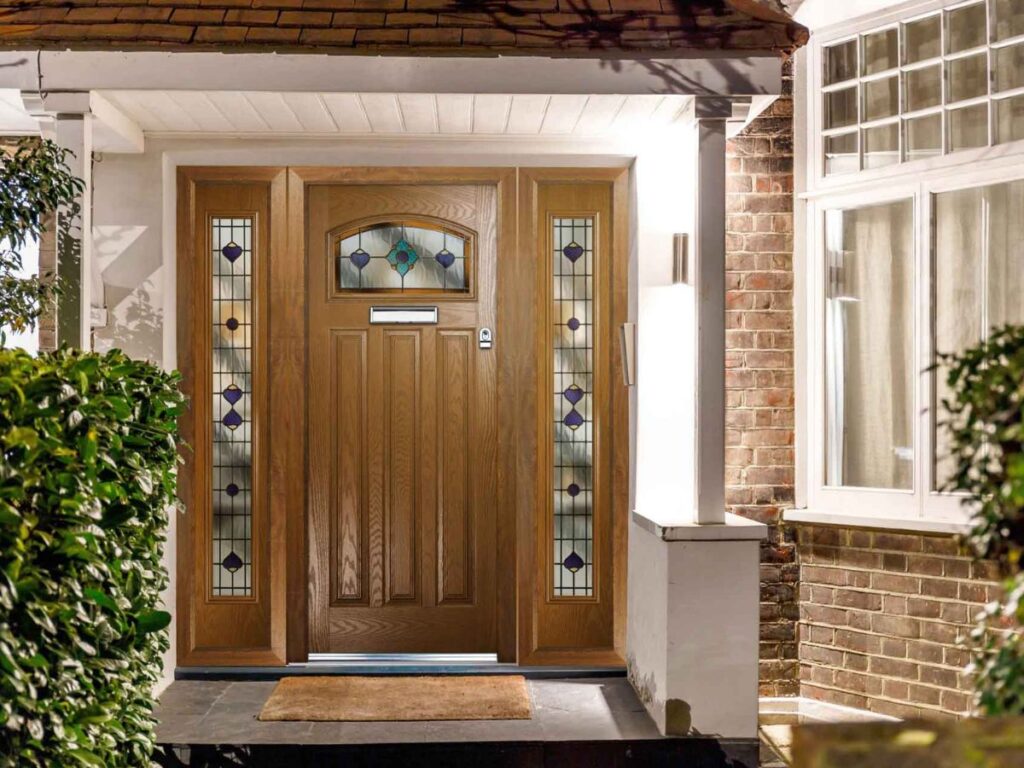
9. Doors with Integrated Drop Seals
Doors with integrated drop seals are designed to automatically close the gap at the bottom of the door when it shuts. This small detail makes a big difference in blocking noise, drafts, and even dust. I’ve explained this feature to clients who didn’t realize how much sound can leak under a door.
Materials Used
- Aluminum or Steel Housings: These hold the drop seal mechanism in place. I came across a project where aluminum housings were chosen for their light weight and durability.
- Rubber or Silicone Sealing Strips: Flexible strips drop down to fill the floor gap. They create a tight seal without damaging flooring.
- Spring or Automatic Mechanisms: Springs or cams trigger the seal when the door closes. This ensures a consistent seal every time.
- Concealed Mounting Systems: Many seals are hidden inside the door’s bottom edge. This keeps the design clean and professional.
- Adjustable Seal Heights: Some systems allow adjustment to match different floor levels. This flexibility helps with uneven surfaces.
Advantages
- Better Acoustic Performance: Drop seals stop sound leaks under the door. This simple feature boosts the overall sound rating.
- Multi-Functional Benefit: Besides noise, they block dust, drafts, and even smoke. I had to highlight this extra value during a hotel retrofit where air leakage was a concern.
- Discreet Design: Integrated seals are hidden from view. This allows businesses to maintain a clean, polished look.
- Energy Efficiency: By sealing gaps, they help reduce heating and cooling loss. This can cut down long-term utility costs.
Things To Consider Before Buying
- Maintenance Needs: Moving parts like springs and strips wear over time. Regular inspection keeps the seals working properly.
- Installation Precision: If the drop seal isn’t fitted correctly, gaps remain. This lowers both acoustic and energy-saving benefits.
- Compatibility with Flooring: Some seals don’t glide well on thick carpets. I once had to suggest alternate models when seals dragged and caused complaints.
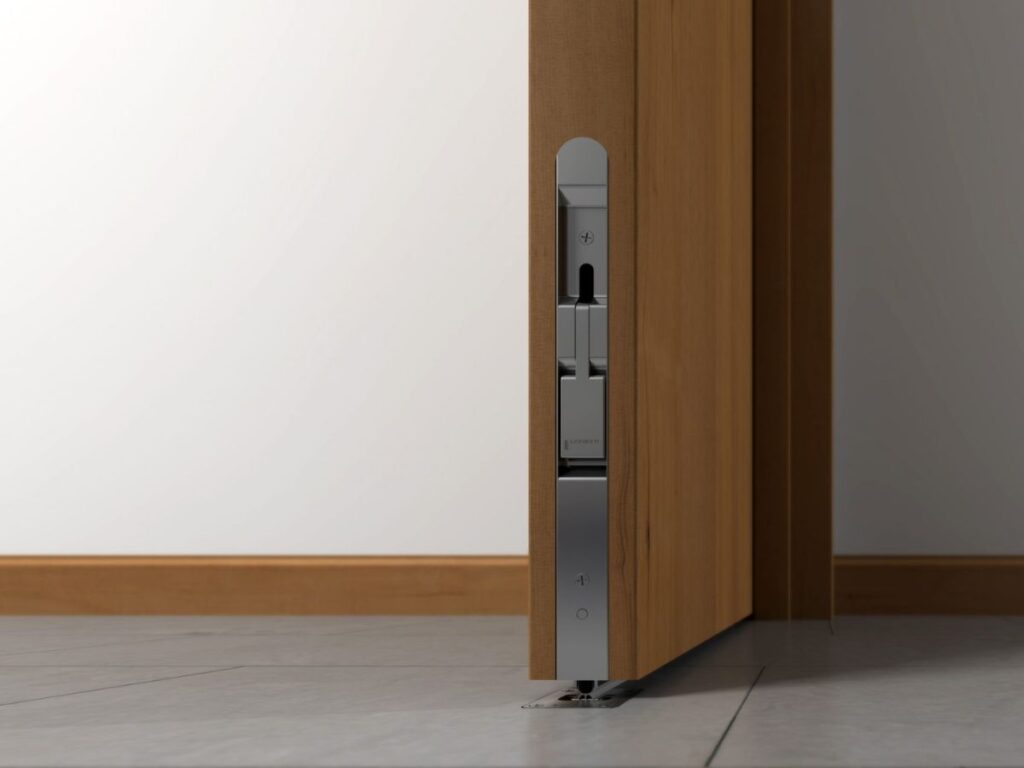
10. 3 Factors To Consider When Choosing Best Doors For Soundproofing
Choosing the right soundproof door is about more than just blocking noise. The best choice usually comes from balancing performance with practicality. Here are some factors for you to consider when making your decision:
#1 Acoustic Performance and STC Rating
Every soundproof door comes with an STC (Sound Transmission Class) rating. This number shows how well the door blocks noise, with higher ratings offering stronger performance.
For hotels and villas, mid-to-high STC ratings are often the best fit to reduce hallway or outside sounds. Comparing ratings side by side helps you decide quickly which option meets your project’s needs.
#2 Durability and Maintenance
A soundproof door should last under constant use without losing its performance. Materials like laminated or composite designs handle scratches, dents, and heavy use better than cheaper alternatives. In busy properties like hotels or offices, durability matters as much as acoustic strength.
When it comes to long-term reliability, Vallisco doors are engineered to resist wear, withstand heavy traffic, and maintain soundproofing quality for years. Their construction emphasizes both strength and low maintenance, giving owners and engineering teams confidence in daily use.
#3 Installation and Cost Considerations
Even the best doors fail if installed poorly. Proper sealing, hardware, and framing are all critical for full soundproofing. You’ll also need to plan around your budget, since advanced doors carry higher upfront costs but fewer long-term issues.
Thinking about cost and installation together ensures you get reliable results without overspending.
Conclusion
That villa project taught me one lesson. Choosing the wrong door can turn a luxury build into a headache.
Now you know which doors perform best. Each option has its strengths, and the right choice depends on your property’s needs.
Do not let noise control be an afterthought. Quiet spaces improve comfort, protect privacy, and add long-term value to your investment.
Contact Vallisco today and let’s build something peaceful together!
Explore More of Our Resources
If you’re searching for more choices, explore our full collection of products. We’ve picked out some great options for you:
Still haven’t found what you’re looking for? Don’t hesitate to contact us. We’re available around the clock to assist you.







